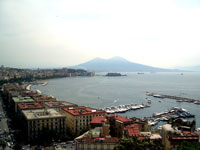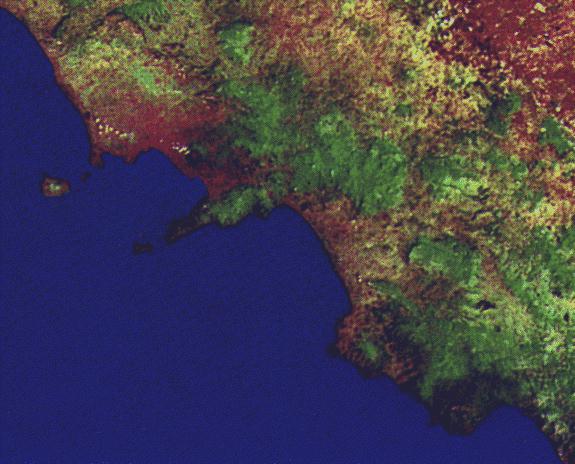Napoli - Naples City

Naples, Napoli in Italian, is the third most-populated city in Italy and the biggest city in Southern Italy. Its close proximity to many interesting sites, such as Pompeii and the Bay of Naples, makes it a good base. Naples is a lively and vibrant city, full of wonderful historical and artistic treasures and narrow, winding streets with small shops, making it worth at least a few days visit. The name comes from the Greek Neapolis meaning new city.
Naples is in the region of Campania in Southern Italy, about 2-hours south of Rome. It sits on the coast on the northern edge of the Bay of Naples, one of the most beautiful bays in Italy. Its harbor is the most important port in Southern Italy.

Incoronata. This church stands along the Via Medina.In its two Gothic aisles, it features frescoes from the 14th-15th centuries.
S. Maria la Nova. Along Via Monteoliveto, this 15th-century church has two Renaissance cloisters; farther on, the Palazzo Gravina is built in the Tuscan Renaissance style.
S. Anna dei Lombardi. The nearby church of S. Anna dei Lombardi can be considered a museum of Renaissance sculpture. Among other things are the marble altarpiece by B. da Maiano (1489); the Pietà in terracotta by G. Mazzoni (1492); a Manger and Saints by A. Rossellino (1475); the Monument to Maria of Aragon by A. Rossellino and B. da Maiano; frescoes by G. Vasari and inlaid stalls in the Old Sacristy.
Spaccanapoli (Via B. Croce and Via S. Biagio dei Librai) runs along an ancient "decumanus." Following this route, you will pass a number of renowned churches and old palazzi, including Palazzo Filomarino, where the philosopher Benedetto Croce lived and died.
Gesù Nuovo. It is a fine example of Neapolitan Baroque, especially in the interior, with its rich colored marble decoration.
S. Chiara. It was rebuilt in the original style (1310-28), of clear Provençal Gothic inspiration and is one of the foremost monuments of medieval Naples. Inside, note the tomb of Marie de Valois by Tino di Camaino and assistants (1333-38), and fragments of the funerary monument of Robert I Anjou by G. and P. Bertini from Florence (1343-45); the inscription "Cernite Robertum regem virtute refertum" is said to have been dictated by the poet Petrarch; it comments on the arts of the Trivium and Quadrivium, or pillars of Medieval Scholasticism, who are shown watching over the funerary statue of the dead king. Adjacent are the convent of the Minorites, with a handsome portal leading into the choir and the Chiostro delle Clarisse, a spacious cloister containing a splendid garden from 1742 at its center; the outside wall of the garden, the seats and the piers are covered with marvelous colored majolica, hence the name.
S. Domenico Maggiore. In the convent adjacent to the church, Thomas Aquinas once taught and both Pontano and Giordano Bruno studied.Inside the church are frescoes attributed to Cavallini (circa 1308) and, in the Cappellone del Crocifisso, a Crucifix on panel from the 13th century, which supposedly spoke to St. Thomas, and a Deposition attributed to Colantonio.
Cappella Sansevero. With 18th-century decoration of colored marble, it is celebrated for the virtuoso statues of Disinganno (Disillusionment, by Queirolo), Pudicizia (Modesty, by A. Corradini) and Christ Veiled (G. Sammartino, 1735).
No less interesting is the Via dei Tribunali, another of the ancient "decumani". S. Paolo Maggiore (1583-1603) is a church set high atop a stairway in the Piazzetta S. Gaetano, the site of the ancient Greco-Roman Forum.
S. Lorenzo Maggiore. One of the most important medieval Neapolitan churches. The first church was built in the 6th century on top of Roman structures which have only recently been brought to light during excavations; this same church was then rebuilt at the express wish of Charles I and Charles II in 1270-75. Of the Baroque renovation, only the facade (1742) remains.
Gerolamini. The interior of the church of the Girolamini (16th-18th century) is an interesting composite example of Baroque decoration, though it is badly damaged; adjacent to the main cloister is a small Pinacoteca.
Pio Monte della Misericordia. Such were the confraternity tasks (corporal works of mercy) that, when the building was undergoing construction (1658), the architect was asked to carve out a space for a portico in the lower part of the facade where the needy could be welcomed. In the 17th-century church are sculptures by A. Falcone and paintings by B. Caracciolo, L. Giordano, and the splendid Acts of Mercy by Caravaggio.
Via del Duomo follows an ancient "cardo" of the Greco-Roman city. The Renaissance Palazzo Como (1460-90), also called "Cuomo", possibly designed by G. da Maiano, is the site of the Museo Civico Gaetano Filangieri, with an estimable collection of Neapolitan paintings, Italian and Spanish arms and armor (16th-18th centuries), European and Oriental ceramics and porcelain, and 16th-century embroideries.
S. Giorgio Maggiore. Rebuilt in the 17th century by C. Fanzago, the church still preserves, at the entrance, the apse of the early Christian building, dating from the 4th-5th centuries.
The Duomo still maintains the soaring 13th-century Gothic interior, with pointed arches and piers, against which 110 ancient columns have been placed. The third chapel in the right aisle is the 17th-century Cappella del Tesoro di S. Gennaro, where the Treasury of St. Januarius is kept. From the left aisle, you can descend to the church of S. Restituta, the first Christian basilica in Naples (4th century).
S. Maria di Donnaregina. There are two churches named S. Maria di Donnaregina: the Nuova (or new) is Baroque (1649), and has an interior frescoed and decorated with polychrome marble; the Vecchia (or old) is an important medieval Franciscan Gothic monument, and contains the sepulcher of Mary, Queen of Hungary by Tino di Camaino and G. Primario (1326) and, in the nuns' choir, frescoes from the first half of the 14th century, by F. Rusuti and others.
Castel Capuano. At the end of Via dei Tribunali, this castle is also known as the Vicaria; built by the Normans and enlarged by the Swabians, it was the royal palace until the 15th century.
Porta Capuana, built in 1484 to a plan by G. da Maiano, is one of the great masterpieces of the Renaissance.
S. Giovanni a Carbonara, which stands high atop an 18th-century staircase, is a church that was founded in 1343, rebuilt at the beginning of the 15th century, and then modified and enlarged.